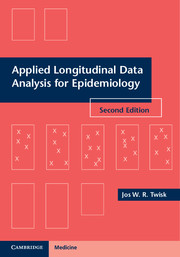Book contents
- Frontmatter
- Contents
- Preface
- Acknowledgements
- 1 Introduction
- 2 Study design
- 3 Continuous outcome variables
- 4 Continuous outcome variables – relationships with other variables
- 5 The modeling of time
- 6 Other possibilities for modeling longitudinal data
- 7 Dichotomous outcome variables
- 8 Categorical and “count” outcome variables
- 9 Analysis of experimental studies
- 10 Missing data in longitudinal studies
- 11 Sample size calculations
- 12 Software for longitudinal data analysis
- 13 One step further
- References
- Index
10 - Missing data in longitudinal studies
Published online by Cambridge University Press: 05 May 2013
- Frontmatter
- Contents
- Preface
- Acknowledgements
- 1 Introduction
- 2 Study design
- 3 Continuous outcome variables
- 4 Continuous outcome variables – relationships with other variables
- 5 The modeling of time
- 6 Other possibilities for modeling longitudinal data
- 7 Dichotomous outcome variables
- 8 Categorical and “count” outcome variables
- 9 Analysis of experimental studies
- 10 Missing data in longitudinal studies
- 11 Sample size calculations
- 12 Software for longitudinal data analysis
- 13 One step further
- References
- Index
Summary
Introduction
One of the main methodological problems in longitudinal studies is missing data, i.e. the (unpleasant) situation when not all N subjects have data on all T measurements. When subjects have missing data at the end of a longitudinal study they are often referred to as drop-outs. It is, however, also possible that subjects miss one particular measurement, and then return to the study at the next follow-up. This type of missing data is often referred to as intermittent missing data (Figure 10.1). It should be noted that, in practice, drop-outs and intermittent missing data usually occur together.
Besides the distinction regarding the missing data pattern (i.e. intermittent missing data versus drop-outs), in the statistical literature a distinction is made regarding the missing data mechanism. Three types of missing data are distinguished: (1) missing completely at random (MCAR: missing, independent of both unobserved and observed data); (2) missing at random (MAR: missing, dependent on observed data, but not on unobserved data, or, in other words, given the observed data, the unobserved data are random); and (3) missing not at random (MNAR: missing, dependent on unobserved data) (Little and Rubin, 2003). Missing at random usually occurs when data are missing by design. An illustrative example is the Longitudinal Aging Study Amsterdam (Deeg and Westendorp-de Serière, 1994). In this observational longitudinal study, a large cohort of elderly subjects was screened for the clinical existence of depression. Because the number of non-depressed subjects was much greater than the number of depressed subjects, a random sample of non-depressed subjects was selected for the follow-up, in combination with the total group of depressed subjects. So, given the fact that the subjects were not depressed, the data were missing at random (Figure 10.2).
- Type
- Chapter
- Information
- Applied Longitudinal Data Analysis for EpidemiologyA Practical Guide, pp. 212 - 236Publisher: Cambridge University PressPrint publication year: 2013
- 5
- Cited by



